
|
|
| www.wildfirenews.com | Archived 08-17-2003 |
|
FIREFIGHTERS PULLED BACK AND RESIDENTS BAIL OUT AS MONTANA FIRES BLOW OUTAUGUST 17 -- MISSOULA, MT: Winds up to 55 mph blew the Black Mountain Fire west of Missoula into an inferno yesterday afternoon, chasing families from their homes as trees exploded on the hillsides and the fire threw brands and rained down ash for miles.
The Missoulian reported that gale-force winds blew from the west, then the northeast, and then seemingly in circles. Fire bosses called for helicopter support, but the winds were too much. "This is too hot, too big," one pilot radioed. "There is nothing I can do." Over the next three hours, the Black Mountain Fire burned more than 3,000 acres, throwing firebrands a quarter mile ahead of itself, igniting dozens of spot fires. As the winds picked up and the fire took off early in the afternoon, crew bosses radioed firefighters to abandon their positions. The fire jumped across O'Brien Creek, but the wind and smoke were too much for even the heavy helicopters. "Move your crews to the safety zones," came the order. "Everybody needs to be off the line." By 3:30 p.m., the last firefighters were safely out of Haggerty Gulch. Apache firefighters from Arizona said they were chased by flames 300 feet high. "Fighting fire is never a fair fight," said Incident Commander Mike Dietrich. "You've got to kick it when it's down, because you know that's what it will do to you." A Red Flag Warning was issued for gusty winds, hot temperatures, low relative humidity, and thunderstorms in southcentral and southeast Montana. An upper-level low pressure area will move into western Wyoming today; this trough will eventually be absorbed into another low across the four corners area, and will then move eastward through the Plains. Moisture and instability ahead and north of the system will cause thunderstorms today from southwest to northeast Montana, through eastern parts of the Great Basin, and over the Southwest. Some dry storms in Montana are expected. The Missoulian has a summary list of the major fires in Montana.
REPLY TO: [email protected] DATE: 08/14/2003 From: James Reim, Assistant Safety Manager, Pacific Northwest Region Recently we have received reports of the hazard of overheating alkaline batteries in clamshell radio packs. In one instance, three batteries exploded and sent out a mist of the corrosive material contained inside the batteries; contacts inside the pack melted from the heat of the batteries. In addition to the potential for injury resulting from such explosion, users of these radios could lose the ability to communicate in an emergency. The problem results from use of clamshells, which were designed for older radios that needed 10 AA cells, in newer radio models. This is a common practice because many radio users prefer the replaceable AA batteries, which are convenient in the field. Ni-cad batteries have better operational characteristics, but they are not easily recharged and maintained during field operations. When adapted for new radios, the older packs use 9 AA batteries and a metal clip in the 10th battery space. In the old-style clamshells with the metal insert, the metal insert can create a circuit within the clamshell, causing it to rapidly overheat. Newer packs come with a spacer already installed. The spacer in the newer packs is not totally metal or is metal with a protective coating. Supervisors should ensure that employees are provided with radios that have battery packs that are designed for, and are compatible with, the models in use. Where it is not feasible to immediately replace older design battery packs that are used on new radios, supervisors should ensure that the users are trained to properly install the batteries, to check the units for defects, recognize problems before a hazardous condition develops, and to correct them. Users should also be trained to understand the nature of hazards associated with damaged batteries, i.e. corrosive properties, and in use of appropriate protective measures, e.g. protective gloves and safety glasses, when handling them. Please contact your unit radio technician for assistance. If there are questions about this safety alert, contact either John Murphy, R6 IRM at (541)278-6468 or James Reim, R6 Assistant Safety Manager at (541)517-3698.
RESOURCES STRETCHED, FIRES GROWINGAUGUST 14 -- BILLINGS, MT: Firefighting resources are stretched so thin now that key personnel and aircraft needed to fight a fire near Nye won't be available for days. Officials are requesting even more help than they normally would for a 40-acre fire, and they've ordered a Type 1 team. Beartooth District Ranger Terry Jones told the Billings Gazette that the Cathedral Peak Fire in the Absaroka Beartooth Wilderness Area is burning in heavy lodgepole, and conditions there make it a threat. "We're real worried about this fire," said Jones. "We put in an order for a Type 1 incident command team, but we're probably not going to get one for several days." The fire is in steep country, where ground crews don't have access. And air support is busy on other fires -- primarily those where homes are threatened. Wilderness fires just aren't a priority right now. "To put people in there would be way too dangerous," Jones said. "Just to get up the steep slopes ... it would be dangerous just walking in to it. The only choice we really have is to use aerial support, and if we can't get those resources, we're pretty much stuck watching and waiting." Jones said the Forest Service will fly over the fire, and he hoped that airtankers or helicopters might be available from other fires. The potential is there for the Cathedral Peak Fire to get really big. "It's not going to go west very far or to the northwest far," he said, "but it has continuous fuel north and northeast, and the fuel is heavy all the way. There are a few ridges with rock, but it would go right over that."
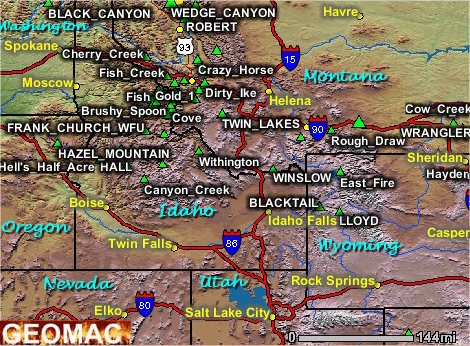 The Missoulian reported that more than a dozen fires have been combined into one complex called the Boles Meadow/Rattlesnake Complex. "We are so short-staffed and there's so much fire," said Virginia Gibbons, information officer. "We haven't even mapped some of the areas." On Sunday, the fire ran in almost every direction; 80 percent of the perimeter was active. "It was running northwest, then northeast, then to the southeast," said Seeley Lake District Ranger Tim Love. "People in Seeley Lake were hitting the panic button. There was ash falling on town, and it was so smoky you couldn't tell where the fire was, or how fast it was moving." By Tuesday night, the Boles Meadow Fire had burned about 4,000 acres southwest of Placid Lake. "It's not an easy fire," Love said. "It's in some thick timber, so there is lots of fuel. We've got a long ways to go with this one." Three new fires were spotted on the Lolo Tuesday, according to information officer Sharon Sweeney. "Since this siege began, we've had about 150 fires on the Lolo. She said incoming teams are warned about the very aggressive fire behavior. "Our largest fuels out in the woods, the big logs, are drier than kiln-dried lumber," she said. "They are at 9 percent moisture. So we're telling teams to stay behind the fires and build good, solid lines."
AUGUST 12 -- WASHINGTON, DC: As the West is pulling out all the stops again for another big fire season, the Forest Service has yet again exceeded its firefighting budget. Yesterday, 366 new fires were reported across the country, and very high to extreme fire indices were reported in Alaska, Arizona, California, Colorado, Hawaii, Idaho, Montana, Nevada, New Mexico, Oklahoma, Oregon, South Dakota, Texas, Utah, Washington and Wyoming. But the Forest Service has already depleted its fire suppression funding for this fiscal year, and is once again raiding other non-fire budgets to pay for firefighting. Total suppression costs this year are estimated to reach $772 million, but the agency's appropriated fire funds run out at $418 million. So they plan to raid $420 million from other accounts to pay for it. Sue Froeschle with the White River National Forest in Colorado said running out of money won't affect firefighting efforts; the Glenwood Springs Post-Independent reported that local USFS officials haven't found out yet how the budgetary shortfall will be addressed. "The Washington office will make the determination as to where the dollars will be transferred from," said Froeschle. A report by the Arizona Republic noted that the Forest Service on Friday transferred $66 million from other programs into its fire suppression account. That money came from funds budgeted for thinning and fuels reduction projects -- the first of several phases the agency will use to keep aircraft in the air and crews fighting fire on the ground. The Forest Service likes to remind its customers that the agency mission is "caring for the land and serving people." A lot of that land-caring mission, though, is now taking a back seat to fire suppression, with budgeted funds for everything from archaeology to fisheries to wildlife to research being frozen and then transferred to the fire program, until or unless Congress approves requested emergency funds for fire -- and that doesn't appear likely any time soon. "Continuing to fight wildland fire safely and efficiently is an integral part of that mission and the agency's top priority," according to Washington Office documents distributed yesterday. "Violating the Anti-deficiency Act is not an option. The Anti-Deficiency Act prohibits federal agencies from spending more money than has been authorized by Congress." Congress has refused to approve needed increases in this year's fire budget -- a supplemental funding bill that would have provided $235 million for fire was not passed. Congress does, though, grant authority to the Secretary of Agriculture to use all agency funds available for fire suppression. Budgets for fish and wildlife and recreation and other non-fire programs can therefore be raided. Funds that are transferred from non-fire accounts are -- usually -- reimbursed later. The agency says it's working with the Administration and Congress to assure that funds will be restored. That's not much comfort, though, to university researchers who have partnership agreements with the agency, or to the non-profit organizations with agreements in place with the agency, or non-emergency programs that both "care for the land and serve the people" later on when funding's restored. In the Forest Service's northern region, the current national focus of firefighting, regional budget officers learned yesterday about the $66 million transfer. The Billings Gazette reported that $40 million of that will come from national forests. About $5 million will come from state and private forestry programs, another $8 million will come from Forest Service research, and $13 million from the overall national forestland acquisition program. Mike Paterni, regional budget director, there there almost certainly will be another round of transfers as the fire season continues. The agency so far this year has spent $50 million more than Congress appropriated. Not until later this week will each region learn how much of the total they'll have to provide. "They are going to look at the unspent balances across the regions," said Paterni. "Then they will equitably prorate everybody's share."
MONTANA FIRES ROCK'N'ROLL AFTER LIGHTNING STORMSAUGUST 11 -- MISSOULA, MT: Scores of fires across the northern region have chased ground crews off the line, more incident management teams and resources are inbound, and Montana's mountain valleys are once again filled with smoke.
The Missoulian reported that crews on Sunday were pulled off fires because of the extreme fire behavior -- huge crowning runs and flying embers spotting miles out in front of the main fires. One fire on the Clearwater in Idaho was throwing firebrands three miles ahead of itself. "Just before things got too scary, we pulled everyone off every fire," said John Huston, the unit fire forester for the Montana Department of Natural Resources. "We had a red flag warning and it proved itself true. With the sheer number of fires and the smoke and haze, we don't even know what all we're working with." Plumes were visible in every direction from Missoula, and fires were on the run in Rock Creek, Schwartz Creek, the Potomac area and Wallace Creek, Boles Meadow, the Rattlesnake Wilderness, Fish Creek and Howard Creek. The Missoula Ranger District itself was working 40 fires. The Billings Gazette reported that erratic winds blew a fire near Big Timber to 30,000 acres yesterday. The Hobble Fire was estimated at 10,000 acres late Saturday night, but ballooned on Sunday; 50 homes have been evacuated and remain threatened. Gray's Type 2 team has been assigned to the fire and will take over today. Don Barry, intel officer with Billings Dispatch, said two outbuildings were destroyed Saturday, and two more on Sunday. The fire ran for about two miles late Saturday night before settling back down around 3 a.m. "It's beginning to turn into a real mess," said Barry. Mike Johnson, a meteorologist for the National Weather Service in Missoula, said more of the same is expected. "Basically, it's going to be dry and windy, with temperatures in the 90s," he said. "And chances for isolated dry thunderstorms remain high." A red flag warning is posted for Missoula and surrounding areas through Monday evening. Greg Greenhoe's Area Command Team is managing the Fish Creek, Cooney Ridge, Bowles Meadow, North Howard, Cherry Creek, and Gold 1 incidents on the Lolo National Forest, Bitterroot National Forest and the Southwest Land Office, Department of Natural Resources and Conservation. Rex Mann's Area Command Team is assigned to the Wedge Canyon, Robert, Trapper Creek Complex, Little Salmon Creek Complex, and Ross Creek fires on the Flathead and Kootenai National Forests and Glacier National Park.
BEAR STARTED ALBERTA FIREJULY 16 -- SLAVE LAKE, ALBERTA, CANADA: A wildfire that could have cut power to not only the Mitsue Industrial Park east of Slave Lake, but also to Nipisi oilfields, was ignited by a bear. Atco Electric employee Danny Schmode said a bear climbing a power pole started the fire Wednesday afternoon. The bear died and dropped to the ground when it touched the powerline, which started line insulators "bouncing." The two powerlines whipped around till they touched, according to the Lakeside Leader, creating a fireball that dropped into the dry fuels below; winds then drove the fire into black spruce. "It's a major transmission line," said Schmode. "It was lucky that crews acted so quickly." Doug Maurice, a ChevronTexaco operator, was driving down the industrial park road as the bear was shinnying up the power pole. "He got fried," said Maurice, "then we saw the torch." He said the fire's speed was amazing. "A fire extinguisher wouldn't have had a chance." Trina Torgerson was traveling down the same stretch of highway when the powerlines began jumping, and said she, too, saw the lines explode. She said the fire was crowning within minutes, and then it took off into the spruce stand. The province's helitack crews were en route minutes later, and three CL-215 airtankers were dispatched from Slave Lake's tanker base. A second group of three tankers was ordered from Lac La Biche, and a B-26 tanker was also dispatched from Slave Lake. It was diverted to a fire in the High Level forest before it could make its first drops. Crews limited the fire's spread to 15 acres and contained it two days later.
WELDING ARC IGNITED NEVADA FIREAUGUST 08 -- JIGGS, NV: A wildland fire that burned 150 acres and threatened one home northeast of Jiggs was ignited accidentally by an Elko company drilling a well, according to a report by the Las Vegas Sun. Employees of Hackworth Drilling were welding during a well-drilling operation, according to Elko Fire Marshal Dave Greenan. "They took preventive measures while they were welding," he said, "but this happened outside their preventive measures. The employees did everything they could to suppress it, but with the winds, they couldn't." Mike McCarty, FMO for the Nevada Division of Forestry, said fire crews had the fire knocked down in a couple of hours. "We do want to commend everyone for the job they did," McCarty said. "They worked in red flag conditions, which is potentially the most severe fire conditions and behavior due to high wind." Several aircraft were called in, including two SEATs from Wells, two heavy airtankers, and one air attack plane.
5,000 EVACUATED BY KINISHBA FIREJULY 16 -- WHITERIVER, AZ: Firefighters expect nasty fire behavior again today on the Kinishba Fire, including crowning and flamelengths of 100 to 200 feet. Crews were pulled from the lines yesterday as flamelengths reached 250 feet; the 12,600-acre fire is 10 percent contained. The communities of Cradleboard, Over the Rainbow, and Jurassic Park are still threatened by the fire, and portions of Whiteriver and a major powerline are also threatened. Thunder thunder cell activity is expected north and west of the fire, and reports from last night estimate the smoke column from the fire at 20,000 feet. About 750 personnel are on the fire, and more resources have been ordered. A second Type 1 team has been ordered and will be on standby in the Show Low and Pinetop-Lakeside community. The Salt Lake Tribune reported that firefighters got a little help from some much-needed rain. On Monday, 5,000 people were evacuated from Whiteriver, the tribal headquarters for the White Mountain Apaches. The fire burned to within four miles of the evacuation trigger point for the Pinetop-Lakeside community about 20 miles to the north, where the summer population reaches 30,000 people. The fire was ignited by lightning on Sunday, and Gov. Janet Napolitano declared a state of emergency in Gila and Navajo counties yesterday, releasing $200,000 in funding for firefighting costs. An AP story from WTVO-TV said tribal police are patrolling vacated homes, and National Guard troops will arrive today. Fire managers said that logging projects, forest thinning, and prescribed burns done by the White Mountain Apache Tribe should help with suppression efforts.
FIRE WEATHER WATCH IN SOUTHERN CALIFORNIAJULY 15 -- SAN DIEGO, CA: The National Weather Service today issued a fire weather watch for the San Bernardino County mountains, Riverside County mountains, the San Bernardino National Forest, the San Diego County mountains, the Cleveland National Forest, and surrounding mountain areas. A fire weather watch is posted for dry lightning over the southwest California mountains for Wednesday afternoon and Thursday. The Fire Weather Center in Riverside predicts isolated dry afternoon thunderstorms over the mountains and deserts of southern California, mainly east of Cajon Pass, through Thursday. Isolated dry afternoon thunderstorms are forecast over the Sierras, mainly from the crest eastward, on Thursday. An increase in moisture will bring cooler temperatures and higher humidity Friday through the weekend. This increase in moisture will also bring scattered showers and a slight chance of thunderstorms, mainly to the Sierras and the southern California mountains and deserts, but some could drift west over the foothills and valleys Friday through the weekend. Temperatures should be in the 80s to low 90s in the mountains, with mid-90s to 105 in the valleys. Humidity is forecast at 8 to 15 percent, and fire danger is very high to extreme.
SOUTHWEST FIREFIGHTERS BUSY
More than 1,000 personnel are on the fire, which is being managed by Raley's Type 2 team. The pueblo and its facilities have been closed to the public for a week. The Albuquerque Tribune reported that fire managers estimate the fire will be fully contained within three days. The fire, ignited by lightning on July 4, is burning in heavy fuels including ponderosa and piñon-juniper in an area that hasn't experienced wildfire for 100 years or more. High fire behavior is a concern due to low RH, high temperatures, heavy timber with high fuel loading, and gusty winds from thunderstorms in the area. The fire's threatening cultural and watershed resources on the pueblo, a number of structures, and high voltage and fiber optic lines in Taos Canyon. Resources on the fire include 16 Type 1 crews, 15 Type 2 crews, 11 helicopters, 32 engines, 11 dozers, and 14 water tenders.
On the Aspen Fire, a surge of monsoon-like moisture has brought the threat of localized thunderstorms to the area, along with erratic gusty winds, blowing dust and ash, lightning, and possible local flash-flooding. The potential is great for road blockages from mudslides and debris loosened by the fire. The Aspen Fire yesterday afternoon, according to Oltrogge's Type 1 team, was at 84,500 acres with 75 percent containment. About 675 personnel are on the fire, including eight hotshot crews, two Type 2 crews, seven helicopters, 40 engines, and 32 water tenders. Authorities have posted a $5,000 reward for information about four to ten people who might have been involved in starting the fire. Gov. Bill Richardson recently announced the release of $5 million in state funds to buy additional firefighting equipment across New Mexico, and the U.S. Senate voted on Friday to approve $314 million in emergency firefighting funds, in addition to the $2 billion already allocated for this year. The emergency spending package, which passed on an 85-7 vote, includes $289 million for the Forest Service and BLM to fight wildfires this summer. It would also provide $25 million for fuels reduction, primarily in the wildland/urban interface. The funds will be available to states where governors have declared a state of emergency. 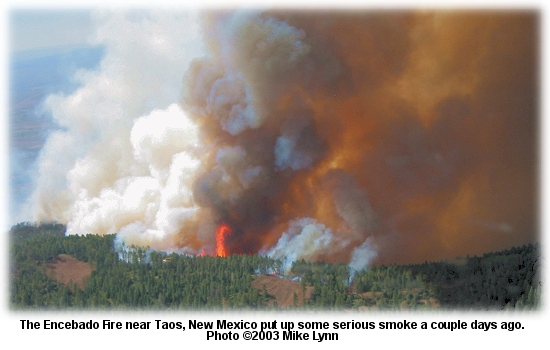
AL-QA'IDA PLANNED WESTERN FOREST FIRESTORMJULY 11 -- BOISE, IDAHO: National forests and grasslands across the West were planned targets for al-Qa'ida attacks, according to an FBI memo sent to law enforcement agencies on June 25. A senior al-Qa'ida detainee told federal investigators about the plan to set summer wildfires in Colorado, Montana, Utah, and Wyoming. "The detainee believed that significant damage to the U.S. economy would result and once it was realized that the fires were terrorist acts, U.S. citizens would put pressure on the U.S. government to change its policies," the memo says. The unidentified detainee said they hoped to create several large, catastrophic wildfires at once, mimicking the firestorm that swept across Australia in 2002. The Forest Service took note of the warning, according to a report by the Arizona Republic, but didn't change any policies or operations plans -- or distribute the information. The U.S. Attorney's Office in Wyoming, which issued the memo, specified that the information was to be distributed on a need-to-know basis only to law enforcement agencies and officers. But many Forest Service law enforcement officers contacted by The Arizona Republic had no idea the warning had been issued at all. The National Interagency Fire Center in Boise decided not to release the warning to the public. The memo indicated that the information from the detainee "may have been intended to influence as well as inform."
Two men at the Mt. Emily Lookout on the Siskiyou National Forest spotted Fujita's plane, though, and reported it. Several small fires started by Fujita were controlled, and fragments of the fire bomb's shell casing were found. He dropped four bombs, only one of which was found -- and only 65 lbs. of that 170 lb. bomb was recovered. The Forest Service kept these incidents pretty quiet, too.
CHAINSAW MAY HAVE STARTED OREGON FIREJULY 09 -- WILLIAMS, OR: The Powell Creek Fire, which started Monday in southwest Oregon, may have been ignited by the use of a chainsaw. Investigators are checking into reports on the cause of the fire; chainsaw use was prohibited by the Oregon Department of Forestry on July 1 in Jackson and Josephine counties between 1 p.m. and 8 p.m. Similar restrictions are in place in eastern and central Oregon. The Powell Creek Fire is burning in timber, brush and slash 13 miles south of Grants Pass. Residents evacuated from Williams have returned to their homes; 28 homes were evacuated and the fire threatened another 45. KOIN-TV reported that 360 firefighters were on the fire, which was 10 percent contained at 350 acres yesterday. Elsewhere in Oregon, firefighters on the 900-acre Link Fire northwest of Sisters are mopping up. It was 60 percent contained last night. A lightning storm on Monday night with over 2,500 recorded strikes ignited more than a dozen fires in southeastern Oregon and nearly 30 in northeastern Oregon.
HEAVY AIR ATTACK HITS NORTHERN CALIFORNIA FIREJULY 08 -- REDDING, CA: A fire that started Sunday evening on the west side of the Sacramento River was nearly contained at 5 acres, but it jumped the river early yesterday and took off. The fire grew to more than 50 acres on the east side by last night, and crews were still fighting the smaller fire on the west side of the river. "The wind just picked it up and took it across the river," said Rebecca Franco with the Shasta-Trinity National Forest. "But it's burning moderately, which is good. It's not a 'blow and go' type of fire yet." Two firefighters with heat exhaustion were evacuated yesterday afternoon, according to the Redding Record-Searchlight. About 250 firefighters, along with four helicopters, four airtankers, and ten engines, were on the fire. Franco said the fire was moving uphill and headed east toward a ridge. Steep terrain with slopes of more than 50 percent has challenged firefighters, and yesterday's work was mostly an air show. "Our one problem is access," said Franco. "It's very hard to get in there. There are no roads to the east side of the river. It's going to take hand crews to hike in there in deep, treacherous, rocky terrain." The Dunsmuir News reported that the point of origin was between the railroad tracks and the west side of the river, within walking distance of a popular day use area. Franco said the fire appears to be human-caused. Wendt's Type 2 team has taken over management of the fire.
THREE KILLED IN COLLISION WITH DOZER TRAILER EN ROUTE TO OREGON FIREJULY 07 -- SUTTLE LAKE, OR: Three people died early Sunday in a collision between an eastbound car and a westbound truck hauling a dozer on its way to the Link Fire. Oregon State Police responded to the crash just before 4 a.m. according to an AP report in the Statesman-Journal, and found all three occupants of the car dead. They have not been identified. The truck had turned from the westbound lane of Oregon Highway 20 near Suttle Lake onto a Forest Service road. The eastbound car hit the rear of the trailer. The truck driver, Richard Caudle, 59, of Prineville, was not injured. The Link Fire was 70 percent contained at 800 acres last night; Morcom's Type 2 team is on the fire, which is 12 miles northwest of Sisters. Some campgrounds near the fire have been evacuated. Fire officials said they will consider the deaths a traffic accident and not fire-related.
SMOKEY BEAR'S VET DIESJULY 06 -- PUEBLO, CO: Edwin Smith, the veterinarian who saved the badly burned bear cub immortalized as Smokey Bear, died June 27 of respiratory failure after a long illness at his home in Pueblo. He was 87. Edwin Smith in May of 1950 treated a 2-month-old cub found clinging to a tree after it was injured on the Capitan Gap Fire on New Mexico's Lincoln National Forest. The cub later was christened Smokey Bear and became the fire-prevention symbol for the U.S. Forest Service. The little bear cub was found crying in a tree by a firefighter who carried him to a local ranger, who took him to the vet. "He was pretty badly burned on his stomach, paws and hind legs when they brought him to me," Smith said. "The infection would have killed him, but I treated him real good." In a 1997 interview with The Pueblo Chieftain, Smith recalled that young Smokey seemed to know that the veterinarian was trying to help him. "Smokey never minded the treatment," Smith said. "He knew that I was helping him and I think he appreciated it. To me, he was always a great patient." Twelve years later, Smith went to visit Smokey at the National Zoo in Washington, D.C., and Smokey responded to Smith's still-familiar voice. "He raised his head, got up and came over to where I had my hands up on the fence by his cage. He put his paws up right by my hands," said Smith.
The Smokey Bear Museum in Capitan houses a collection of Smokey memorabilia. According to the Journal of the American Veterinary Medical Association, the Smith Veterinary Hospital in Santa Fe was opened in 1946. The practice was eventually turned over to Smith's son, Dr. Tom Smith. Tom was later assisted by a third generation of the family; his daughter, Dr. Kathy Smith-Dobesh, now runs the clinic with her husband, Dr. Mike Dobesh. In 1994, following his semi-retirement, Smith and his second wife, Twilla -- they married in 1982 after both were widowed -- moved to Pueblo. He became an active volunteer at Pueblo's First Presbyterian Church, Meals On Wheels, and the Cooperative Care Center, which distributes food and clothing to the needy. The Forest Service, National Association of State Foresters, and Advertising Council honored Dr. Smith with the Bronze Smokey Bear Award at a ceremony and reception in Pueblo. The Bronze Smokey is awarded for outstanding contribution to local or statewide fire prevention efforts. Survivors include his wife; two sons, Richard and Gordon Smith; a brother, Earl; 23 grandchildren and 19 great-grandchildren.
SOUTHERN CALIFORNIA ROCKS'n'ROLLSJULY 05 -- RIVERSIDE, CA: Initial attack activity has ranged from moderate to heavy today, with a number of new fires in the southern California area. The Dinely Fire on CDF's Tulare Unit, the Alabama Fire on the San Bernardino National Forest, the Murphy Fire and Camanche Fire (both on CDF's Tuolomne-Calaveras Unit), the Hopper Fire on the Los Padres, the Mine Fire on CDF's Riverside Unit, and the Rainbird Fire on CDF's San Diego Unit all had more than one aircraft on them this afternoon.
The Hopper Fire tonight was 50 percent contained at about 30 acres; the Hunter Fire in Mariposa was contained at 562 acres. About 580 firefighters worked the Hunter Fire, which started Thursday morning southwest of Yosemite National Park. Two firefighters were treated for heat exhaustion. The suspected origin of the fire was sparks from a metal grinder in an area not cleared for defensible space. The Stage Fire south of Hemet, which started about 2 p.m. yesterday, was reported at 5 acres initially; it was at 200 acres by 3:30 p.m. and by 5 p.m. had grown to 1500 acres and had a "no divert" order on aircraft in effect because of the threat to structures. It was 25 percent contained about an hour later and was contained tonight at 1500 acres. The Mine Fire on Santa Rosa Mine Road was contained at 100 acres after threatening several structures. The Alabama Fire this afternoon had three airtankers assigned (Tanker 07 and two CDF S-2's) along with three helicopters and a helitanker.
FIRES ON THE FLATHEADJULY 04 -- RONAN, MT: Six fires in the Dixon-Perma area are being managed as the Dixon Complex by Chrisman's Type 2 team, according to the Missoulian; Germaine White, fire information officer for the Confederated Salish and Kootenai Tribes, said the fires on the Flathead Reservation are all lightning fires that started last Monday. The complex is 40 percent contained at 470 acres.
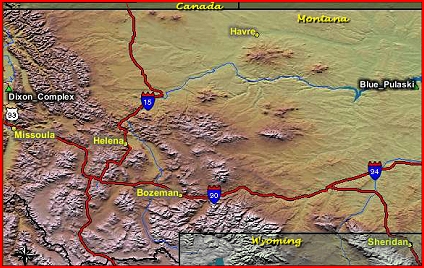 "Two of the fires are located northeast of Perma," said White, "and four are located southwest of Dixon. Serious hazards exist for the firefighters with areas of heavy timber and snags along with steep, rocky slopes." White said the fires are burning in ponderosa and Douglas-fir, and the Selow 2 fire is the most serious. The other five fires are 80 to 100 percent contained, with extensive mop-up under way. Twelve crews, two helicopters, four dozers, and ten engines are on the complex. Hawkaluk's team, meanwhile, reported that the Blue Pulaski Fire near Jordan, Montana, is about 500 acres with zero containment. Three helicopters and an engine crew are assigned, and the fire's being handled under a confinement plan.
DON'T SHOOT, IT'S A BAMBI BUCKETJULY 03 -- PUNKIN CENTER, AZ: A Tonto Basin rancher is facing criminal charges for using a shotgun to defend his water supply from a firefighting helicopter last month. Federal prosecutors say Clarence Conway, 59, blasted a bucket as the helicopter hovered over his stock pond dipping for water to fight the 12,500-acre Picture Fire near Punkin Center. Conway was arrested shortly after the incident, according to the Arizona Republic, then released. He was indicted yesterday by a federal grand jury on a single count of interfering with the performance of federal officials or contractors. If convicted, he could face up to a year in prison. Clark Derrick, Conway's attorney, said the rancher had filed a claim last year against the Forest Service after firefighting aircraft used more than $2,000 worth of his water to fight a fire. Derrick said the government never paid that claim, and Conway had warned the Forest Service not to take any more water from his ranch because he was concerned about the welfare of his cattle. A prosecuting attorney said two shots were fired at the bucket, but the helicopter was not hit.
ONE BURNED AND ONE CHARGED IN NINE MILE FIREJULY 01 -- OROVILLE, WA: A man was critically burned trying to protect a home from the Nine Mile Fire, and another was charged with reckless burning in the 900-acre wildfire in north-central Washington. According to an AP report in the Register-Guard, Charles Eder Jr., 66, of Oroville was flown to Seattle's Harborview Medical Center for burn treatment yesterday. He was driving a bulldozer trying to protect a neighbor's home when the fire overtook him. He was burned over 12 percent of his body, including his arms, legs, hands, and face. Timothy D. Algaier was cited for reckless burning, according to Okanogan Sheriff Frank Rogers, and is accused of setting fire to hay that was cleaned out of his dog kennels. Gusty winds blew the flames into nearby grass and out of control. The Nine Mile Fire is expected to be contained this afternoon. Airtankers from Canada were dispatched yesterday, and helicopters were standing by today. Several other fires in the Methow Valley Ranger District of the Okanogan-Wenatchee National Forest were ignited by lightning. The Sweet Grass Fire northwest of Winthrop was at 70 acres, and had forced the closure of Ortell Creek Road. The 20-acre Fawn Peak Fire northwest of Winthrop is burning in heavy slash over steep terrain; rappellers are being assigned this afternoon.
FIRES WHIP THROUGH DRY BRUSH IN SOUTHERN CALIFORNIAJuly 01 -- TEMECULA, CA: Wildfires burning through dry brush and grass in southern California have threatened homes in Kern County and Riverside County; one fire burned 1,200 acres near the tiny community of Lebec in Kern County. The Tejon Fire was 95 percent contained this morning, with full containment expected by 6 p.m. Kerrigan's CDF team is managing the fire and crews are mopping up. Protection remains in place for a primary power transmission line and residences in Frazier Park and Lebec. An AP report in the Sacramento Bee said the fire initially forced about 400 people from their homes before 800 firefighters got a handle on it; 17 hand crews and 92 engines, along with two helicopters and two dozers, were on the fire. "They just did an incredible job keeping it away from structures," said CDF information officer Sharron Torrence. "But with temperatures and winds rising, low humidity, and the 4th of July weekend ahead, we have the conditions for a disaster if people are not careful."
In northern California, the Friday Fire on the Six Rivers National Forest was 90 percent contained this morning at 485 acres. Wendt's Type 2 team is managing the fire, which is on Highway 299 west of Salyer. They expect to have the fire contained this evening; 639 personnel are on the fire, including 21 crews, 33 engines, two dozers, and two helicopters. The fire's in extremely difficult terrain, burning in old growth manzanita with mixed-conifer overstory; some torching occurred yesterday. The priority today is holding and completing the fireline. The CDF Northern Region announced today that all residential "Dooryard" (Form LE-62) burn permits within state responsibility area and local responsibility areas under contract to CDF are suspended. Agriculture, forest management, and other industrial-type burning may proceed if a CDF fire official has inspected the area and issued a permit. Campfires will be allowed only in designated campgrounds.
FIREFIGHTERS INJURED IN VAN ROLLOVERJUNE 30 -- MAPLETON, OR: Four contract firefighters were transported to area hospitals with moderate injuries when their van overturned east of Mapleton as they returned from fighting the 650-acre Sulfur Creek Fire last night. The Register-Guard reported that the Skookum van rolled on Highway 126 while carrying 10 crewmembers, including a driver who apparently fell asleep at the wheel. Two of the firefighters were taken to Sacred Heart Medical Center in Eugene, while the other two were taken to Peace Harbor Hospital in Florence. At least one suffered severe head lacerations. Six others were in the van, including the driver, who suffered minor injuries. Three of the four had been treated and released by 10 p.m. Sunday, and the fourth was expected to go home later in the night, Skookum owner Scott Coleman said. "All these guys had their seat belts on and that's probably why they're okay," said Coleman. The van, a Ford Econoline E-350, is the same model that was involved in a fatal crash last summer of a Grayback crew in Colorado. But Coleman said the van was not a factor in Sunday's crash. "The driver was drowsy," he said. "These guys are working hard and working long hours." The crew had been on the Sulphur Creek Fire just outside the Siuslaw National Forest; fanned by gusty easterly winds, the fire spread rapidly late Saturday and early Sunday, with 40-mph gusts foiling firefighters' attempts to line and backburn the fire. It grew from 200 acres on Saturday to 650 acres Sunday, with containment of 30 percent, then 10 percent, then back up to 35 percent. The recent hot weather was cited as the main reason for the fire's overnight growth. "It just takes a few weeks of drier weather to dry out all the fuels," said Cynthia Orlando, a public information officer for the Oregon Department of Forestry.
97 FIRE CLOSES HIGHWAYJUNE 30 -- WEED, CA: A 400-acre grass fire north of Weed that forced evacuations yesterday was 95 percent contained this morning, according to the Dunsmuir News, and crews were expected to begin mop-up by this evening. The fire was reported just after noon yesterday near Highway 97 with winds over 20 mph and gusts to 36 mph. CDF officials ordered the evacuation of the Mount Shasta Vista subdivision near Big Springs. The Siskiyou Daily News reported that about 40 residents were evacuated and Highway A-12 was closed between Highway 97 and Harry Cash Road. The fire was actively burning in brush yesterday; it started at a residence and, driven by brisk south winds, burned to the north. Firefighters made a stand at Highway A-12, but the fire jumped the road. It was slowed by airtanker and helicopter drops, some of which landed on firefighters along A-12. Siskiyou County Sheriff's Lt. Gary Peery said retardant drops stopped the flames while leaving their telltale red marks on everything around them. "If you see any sheriff or CHP units colored pink," he said, "it's from the fire retardant, not a change in patrol car colors." Twenty-two engines, four dozers, one hand crew, two helicopters, a water tender, and a total of 99 personnel worked on the fire. The evacuation orders were rescinded this morning as winds died down. The fire destroyed one outbuilding, a travel trailer, and a wood pile.
UTAH FIRE CLOSES HIGHWAYJUNE 30 -- ST. GEORGE, UTAH: A voluntary evacuation of the Shivwits Reservation was recommended, and Old Highway 91 from Gunlock to Mesquite, Nevada, was shut down as the Apex Fire grew to 6,600 acres late yesterday. The Washington County sheriff's office said about 100 people were affected. The Reno Gazette-Journal reported that the fire was about ten miles west of St. George and five miles from the reservation in southwestern Utah, burning in piñon-juniper on federal, state, and private land. David Boyd, BLM fire information officer, said erratic winds pushed the fire in all directions; temperatures in southern Utah reached the 100s. The Salt Lake Tribune reported that the fire was visible from St. George as it burned along on Utah Hill; officials believe the fire started near a road in Mine Valley. "It's in steep, rugged terrain," said Boyd. "It's not moving in one direction. It's moving outward." The Spectrum reported that the fire edged near the OMG Apex Chemical Facility, where airtankers dropped retardant. Several poles on a small powerline were destroyed, and the fire threatened a 500KV powerline, a radio tower, and the Apex Mine. More than 120 firefighters, two heavy airtankers, three SEATs, and five engines were on the fire; KSL-TV reported that part of the fire slowed Saturday evening after it spread into an area that had burned several years earlier. The Wooden Shoe Fire in the Abajo Mountains of southeastern Utah is burning about 30 miles from Blanding; it was at 550 acres last night.
CALIFORNIA FIRE CLOSES FREEWAYJUNE 30 -- LEBEC, CA: Residents were evacuated from about 200 homes as a 500-acre wildfire ignited by a vehicle fire burned across the hills south of historic Fort Tejon State Park; according to NBCSandiego.com the 1,000-acre Tejon Fire started yesterday afternoon when a pickup hauling a trailer filled with car parts caught fire on the south side of the Golden State Freeway 40 miles southeast of Bakersfield. Winds pushed the fire quickly through dry grasses. An AP report said the fire threatened some 200 houses lining two canyons along the west side of the freeway. About 350 local, state, and federal firefighters were assigned to the fire. "We have crews of firefighters in among the homes, and we have other crews using backfires," Kern County Fire Capt. Doug Johnston said. Officials evacuated several hundred people near the town of Lebec. "Lebec consists of a post office, an antique store, and a mini-mart," said innkeeper Debbie Peters. "There is really not much you can do when a wildfire is coming."
ROLLOVER KILLS VOLUNTEER FIREFIGHTERJUNE 29 -- SILVER CITY, NM: A Cotton City, New Mexico, fire chief was killed Thursday evening when a tanker truck he was driving overturned and fell down a canyon. The Animas Volunteer Fire Department tanker was en route to the 3,500-acre Jenny Fire southwest of Beaverhead. The Silver City Daily Press reported that Ralph Dawdy, 47, was driving north on Wall Lake Road about 7:45 p.m. Lt. Eddie Flores of the New Mexico State Police said the tanker failed to negotiate a turn, left the road, and rolled several times before landing at the bottom of Terry Canyon. Dawdy was ejected from the vehicle. Investigators said Dawdy was not driving recklessly or too fast; he was pronounced dead at the scene. A report by firehouse.com said Dawdy worked full time as Chief of the Cotton City Fire Department in Hildago County, and also served eight years as a volunteer firefighter with Animas Volunteer Fire and Rescue. Animas dispatcher Jared Fralie said another firefighter was following Dawdy when the accident occurred; he came around the same curve in the road just in time to see Dawdy's tanker going over the edge. "We're slowly getting through it," said Fralie. "It's been a shock to us all; it really shook the community up." Dawdy is survived by his wife and two children; a memorial service is scheduled for Tuesday, July 1 at 10 a.m. at the Animas High School, and at the 4th of July parade in Rodeo, 20 miles west of Animas, fire departments will gather to honor Dawdy. Animas Volunteer Fire and Rescue, the Cotton City Fire Department, and three other fire departments serve a rural ranching and farming community of 500 square miles. This is the department's first line of duty death.
FIRE AT DAVIS LAKE CLOSES CAMPGROUNDSJUNE 29 -- CRESCENT, OR: A fire that began yesterday afternoon on the south shore of Davis Lake has forced the evacuation of two nearby campgrounds; it was estimated at over 1,000 acres late last night. Roland Giller with Central Oregon Interagency Dispatch said the fire put up a smoke plume of about 20,000 feet. The Cascade Lakes Highway around the lake was blocked at several points, and firefighters evacuated West and East Davis Lake campgrounds at about 5 p.m., but Lava Flow campground was still open last night. KATU-TV reported that Deschutes County Marine Patrol boats were used to remove some campers. Jackson's Type 2 team is on the fire. The Bend Bulletin reported that the Davis Fire jumped the Cascade Lakes Highway at about 6:30 p.m. and headed up Hamner Butte south of the lake. Davis Lake is one of the most popular flyfishing-only lakes in the Pacific Northwest, known for its alpine setting and lunker trout. It's a large, shallow lake that was formed about 6,000 years ago when a lava flow cut off Odell Creek. Davis Lake and adjacent Davis Mountain are named for "Button" Davis of Prineville, who ran stock in the vicinity of Davis Lake in the 19th century. With no lightning in the area since June 17, fire officials said the fire was probably human-caused. Two airtankers were on the fire, along with six crews, ten engines, and a couple of water tenders. Personnel from Gilchrist, Crescent, La Pine, Bend, the Oregon Department of Forestry, and the Forest Service were on the fire; firefighters retreated from the wind-blown fire at one point. Another fire started in the Cascades yesterday seven miles east of Breitenbush Hot Springs in the Mount Jefferson Wilderness. The Bear Lake Fire burned about 30 acres in hemlock and fir. In the Coast Range, crews were working on containment of the Sulfur Creek Fire burning in second-growth fir 20 miles east of Florence. The initial incident commander, Greg Wagenblast, said stiff east winds blew the fire over established lines; four helicopters were on the fire. The Register-Guard reported that easterly winds of up to 20 mph fanned the fire to 200 acres yesterday. Crews had the fire about 30 percent contained by late last night, said Craig Mackey, incident commander with the Oregon Department of Forestry. Firefighters are hoping for calmer winds, higher humidity, and maybe a little rain. "This is really frustrating," said Mackey. "This is almost like August conditions." Rugged terrain nearly vertical in spots, with only one narrow road leading in, along with shifting winds, made for difficult work. Some firefighters were pulled off the fire yesterday to fight a fire started by a camper at the 10-Mile Creek area near Yachats. About 100 firefighters, including 30 inmates from Shuttercreek Correctional Facility in Coos Bay, worked 12-hour shifts on the Sulfur Creek Fire. Eight water tenders were assigned, with four helicopters and an air attack. "We're just trying to find a good anchor to flank it and pinch it off," Mackey said last night.
WINDS PUSH KERN COUNTY FIREJUNE 28 -- LAKE ISABELLA, CA: About 200 homes and two campgrounds were evacuated as a wildfire burned through a recreation area of Kern County this morning; over 300 homes are threatened. The Sawmill Fire destroyed one house, a mobile home, and several outbuildings Thursday, then blew up yesterday afternoon when winds picked up. An AP report in the Mercury-News said the fire was 80 percent contained at 200 acres -- and then took off to 400 acres. "We're a couple squares back," said Kern County Fire Capt. Doug Johnston. "We had some stiff winds come up, changed the ballgame on us." The Daily Bulletin said the fire was reported late Thursday afternoon in a home, and the flames spread rapidly to 140 acres in hot, windy weather. Bulldozers were cutting a firebreak Thursday night to keep the fire from advancing over a ridge to the Hungry Gulch campground. Tony Diffenbaugh with Kern County Fire said if the fire had burned over one ridge, it could have grown to several thousand acres. "Every year we get fires up here," he said, "and it's like déjà vu." Johnston said another grass fire was burning a few miles down Kern Canyon. Another 350-acre fire on an Indian reservation near Palm Springs was contained early Friday and a 25-acre fire in Calabasas was contained overnight.
CHEDISKI FIRE STARTER SERVED WITH PAPERS -- AND JAIL TIMEJUNE 28 -- PHOENIX, AZ: Valinda Jo Elliott, the woman who started the Chediski Fire last year, was served yesterday with papers in a civil action filed by the White Mountain Apache Tribe. She was also sentenced to 60 days in jail and a $900 fine for a drunken driving charge dating to an arrest for DUI last December. The judge told Elliott, 32, of Phoenix, that the 60-day term was warranted because Elliott put Arizona residents at risk by drinking and driving; according to the Arizona Republic, she had registered a blood-alcohol level of 0.177 percent, more than the 0.15 percent level considered extreme DUI under Arizona law. While in court, she was served with a civil action filed in tribal court accusing her of a variety of wrongs, including leaving an unattended fire. She has until July 27 to file an answer. If found liable, Elliott could be fined as much as $4,000 -- along with damages resulting from the Chediski Fire. An Associated Press report said the civil complaint alleges that Elliott disobeyed an executive order banning people from certain areas of the reservation, located in eastern Arizona, because of extreme fire danger. Chadeen Palmer with the tribe said Elliott could be held liable for the cost of rehabilitation of the burned land, expenses associated with the fire she started, and punitive damages. Tribal members, especially older people, were devastated by the loss of the forests, said tribal Chairman Dallas Massey, Sr. But they won't leave. "For Apaches, we're here, we're not going anywhere," Massey said. "They might go away for an education, but they come back. They always come back. ... That's why people feel so hurt, because we can't just pack up and leave." The replanting effort of the burned forests, according to another AP report, began earlier this year with massive seeding efforts. Four million pounds of grass seed were spread over the Apache mountainsides. A riot of grasses and wildflowers sprang up in many blackened areas. Oak branches began to sprout from blackened stumps left by the fire and salvage logging operations. Some 730,000 seedlings will be planted by hand over 6,600 acres this fall, and another 24,000 acres will be planted over the next two years. But the replanted areas will amount to just 11 percent of the tribal land damaged by the fire. The fire effectively ended the White Mountain Apaches' timber industry, which had provided about 60 percent of the tribe's income. Elliott said she had been lost on the Fort Apache Reservation for two days when she used a lighter on June 20 last year to set fire to a bush to get the attention of a TV news helicopter crew. The crew rescued her. The Chediski later merged with the Rodeo Fire and destroyed 467 homes and burned almost 469,000 acres -- 270,000 acres on the reservation. The fire forced the evacuation of 30,000 people.
LA GRANDE TANKER BASE WILL BE UPGRADEDJUNE 27 -- LA GRANDE, OR: After years of service, the base at the Union County Airport was showing its age: temporary buildings for employees, an old shingle-covered structure for the base administration, and run-down aircraft facilities. Scheduled up now, though, are two new concrete loading pads and an improved tank farm. Matt Reidy, Wallowa-Whitman National Forest fire staff, said concrete for the pads has been poured and trenches to capture retardant spill have been dug. The pads and tank farm, according to the La Grande Observer, will be ready to go by July 14. Reidy said tankers won't fly in to the base during construction, and the two new buildings will come later this year. The $2.4 million project at the Northeast Oregon Interagency Fire Center should be completed by December. A Portland contractor, John Cisneros Construction, will build the new base; they handled renovations at the Redmond base, too. Improvements will include new quarters for base administration and two local Type 1 crews -- The La Grande Hotshots and the Union Hotshots. The new administration building will include a ready room, a kitchen, and a rest area. "This is long overdue," said Reidy. "We've been limping along, and now we have plans to make this a first-class operation."
IF A TREE FALLS IN THE COURTROOM AND NO ONE'S THERE TO HEAR IT, DOES IT STILL MAKE A SOUND?JUNE 27 -- WASHINGTON, DC: With wildfire season well under way, a Senate committee yesterday considered legislation that would accelerate projects to reduce fuels in forests at risk of catastrophic fire. "The long, hot summer of forest fires has already begun," said Sen. Larry Craig of Idaho. The Senate Agriculture Committee debated the bill, which would allow federal land managers to accelerate logging and prescribed burning on 20 million acres of federal land. KVAL-TV reported that the high-risk areas would be exempt from some environmental reviews; the bill would also limit administrative appeals and direct judges to expedite court challenges. Under rules enacted last month, projects of up to 1,000 acres in at-risk areas could be "categorically excluded" from environmental reviews and administrative appeals. Michael Petersen of The Land Council, an environmental group based in Spokane, told the committee that efforts to treat forests need to be focused more on the wildland/urban interface. "We can't and shouldn't fireproof our forests," he said, "but we can work toward fireproofing our communities." He expressed concerns that the bill would allow environmentally damaging projects to go ahead without adequate environmental review. Senators Ron Wyden of Oregon and Dianne Feinstein of California introduced an alternative bill that would authorize up to $3.8 billion to thin up to 20 million acres. It would speed appeals from 90 to 60 days, prohibit cutting of old-growth trees, and protect roadless areas. In Oregon, the measure would speed up proposals to log timber burned in the Biscuit Fire.
Both projects were planned to remove trees killed by wildfires during the summer of 2000; the sales were among those included in a burned-area settlement agreement negotiated by environmentalists, loggers, and Forest Service officials more than a year ago. Hogan was the mediator for that agreement, which restricted the cutting of trees over 22 inches in diameter without prior agreement of the plaintiffs -- the environmental groups that sued to stop the sales. The Missoulian reported that Bitterroot managers figured the prohibition applied only to green trees. Forest Supervisor Dave Bull said virtually all the trees on those sales are now dead, and they wanted to remove all but a few of them. "If we make an investment in reforestation," he said, "we don't want to lose it 20 or 30 years from now, when all those trees are lying on the ground and at great risk of burning." But the environmentalists said no, that the agreement applied to all trees over 22 inches in diameter. The disagreement went to Hogan for resolution, and he denied the Forest Service's motion. "We'll do an assessment with our fire people and our reforestation people," said Bull, "and determine whether we did get an adequate amount of fuel reduction so the risk of fire in the future is something we can live with."
TEENAGERS ARRESTED FOR ARSON IN ALBUQUERQUE FIREJUNE 27 -- ALBUQUERQUE, NM: Three teenagers have been charged with arson in at least one of the two fires that burned along the Rio Grande in Albuquerque this week and forced the evacuations of hundreds of people. An AP story in the San Francisco Chronicle said Ricky Navarette, 16, Fernando Anaya, 13, and Steven Sedillo, 13, all of Albuquerque, were booked into the Bernalillo County Juvenile Detention Center this morning. Albuquerque police Sgt. Beth Paiz said they were charged with arson, conspiracy to commit arson, criminal damage to property over $1,000, and tampering with evidence. Paiz said authorities are still investigating whether the fires are connected, and they're not saying which fire the charges pertain to. Mayor Martin Chavez said Thursday they haven't ruled out a connection between the two fires. Evacuated residents returned to their homes yesterday as firefighters mopped up after the fires. Sexton's Type 1 team took over the Montano Fire yesterday, which was at 50 percent containment last night. "The fire situation is extreme," Sexton said. "There's a potential for an accidental ignition to grow very quickly." The two fires were originally estimated to have burned about 700 acres each, but that figure was reduced when GPS mapping was conducted. Gov. Bill Richardson has ordered a 19-mile stretch of the parched bosque in Albuquerque closed through July 4. The area is bounded by Sandia Pueblo on the north and Isleta Pueblo on the south.
ALBUQUERQUE EVACUATES RESIDENTS AGAINJUNE 26 -- ALBUQUERQUE, NM: Helicopters began the assault on what was probably an arson fire at daybreak today, dropping water over a blaze about five miles north of town. The fire started last night and burned more than 700 acres, according to ABC News, threatening homes and forcing more than 200 people to evacuate. Albuquerque Fire Lt. Lynn Reule said the wildfire was contained this morning but not yet controlled. Mayor Martin Chavez said the evidence suggests the wind-driven fire was not a flare-up of the Atrisco Fire the day before, about a mile to the south. "It has more than one point of origin which is suggestive of arson," Chavez said. Gov. Bill Richardson called up National Guard resources and requested federal help. Hundreds of homes and apartment complexes were evacuated. Chavez said more than 100 homes were "very severely compromised" and 200 to 250 people were ordered to evacuate. Chavez said firefighters would be working strictly structure protection and would not be fighting the fire near the river; much of that area is drought-parched salt cedar and cottonwoods. More information on Southwest region fires is available from the Southwest Area Coordination Center on their Morning Briefing page.
IS YOUR FIRE DEPARTMENT MISSING OUT ON FUNDING?JUNE 25 -- DENVER, CO: Colorado may be losing thousands of federal dollars aimed at fire prevention and suppression because fire departments don't tell the state how many fires they've fought. Less than half the state's fire departments are eligible for federal Fire Act Grants, according to a survey conducted by the state's Division of Fire Safety, but some fire departments have received up to $100,000. According to an AP report on thedenverchannel.com, many mountain districts and small volunteer departments don't report their fires to the state because of a lack of staff or confusing software. "It's been a perennial problem for years and years that we haven't always known exactly how many fires we have," said Bill Wallis, state FMO for the Bureau of Land Management. The state Legislature last year mandated an accurate count of fires -- but provided no money for it. Kevin Klein, director of the Colorado State Fire Chiefs Association, has since 1997 been asking lawmakers for money to count fires. "We don't know how much more we could get, because we don't know exactly how much we're missing," he said. The Denver Post noted that a fire department's reporting of fires is one of the factors used to apportion grant money. "It could be hundreds of thousands of dollars, it could be a million," said Klein. "It would just be a wild guess. That's the problem; we don't know how much more we could get because we don't know exactly how much we're missing." Justin Dombrowski, wildland coordinator for the Boulder Fire Department, said the amount of money passed up certainly reaches into the hundreds of thousands of dollars and likely into the millions. He said if only a handful of the more than 200 ineligible fire departments in Colorado received FIRE Act grants, the funds awarded would total over $1 million. Because there are numerous grant sources, even more money is at stake. As of Friday, 462 wildland fires had been reported in the state, according to Larry Helmrick of the Rocky Mountain Area Coordination Center. But a survey of some departments found that number should be higher. Most of the 97 fires fought by El Paso County's Black Forest Fire Rescue Protection District, for example, were not reported because of confusing software, according to Franklyn Blaha, Black Forest's Emergency Medical Services Coordinator. Besides money, a state forestry official worries that airtankers and other resources could go to other states. Bill Graepler, an assistant forester in the Colorado Department of Forestry, said if they're not showing an accurate count of fires, they could lose the airtanker based at Jeffco. "It could go to Idaho," he said.
FIRE IN ALBUQUERQUE - 1,000 EVACUATEDJUNE 25 -- ALBUQUERQUE, NM: A wildfire that leapt the Rio Grande forced about 1,000 people -- including the mayor's family -- to temporarily evacuate their homes as it burned through 700 acres of brush along the river. The fire caused a power outage that left 16,000 homes and businesses in the dark, and Interstate 40, which crosses the river, was shut down for several hours. Albuquerque Fire Chief Robert Ortega said the fire was probably started by fireworks. ABC News reported that most of the evacuated residents were allowed to return last night; firefighters were still mopping up spot fires this morning. Fire Department Lt. Lynn Reule said about 50 firefighters were on the fire today, down from a peak of 140 yesterday. The fire burned along the west side of the Rio Grande, then jumped the river. "You can see the flying embers, it's scary," said resident Liz Lardizabal. "The whole street in front of our house is solid with fire trucks." The Albuquerque Tribune reported that the fire was not as disastrous as it could have been. The only house that burned was a vacant one under construction. But Chief Ortega said they were just seconds away from disaster. "It's amazing that we didn't lose more structures than we did," he said. "If we didn't have that air support, I'd say we would still be fighting a large-flame fire right now." Mayor Martin Chavez has already accelerated the city's $350,000 annual bosque clearing efforts, pushing the city to finish clearing the 3,000-acre forest in five years instead of ten.
WEATHER'S NOT HELPING ARIZONA FIREFIGHTERSJUNE 24 -- TUCSON, AZ: Firefighters fanned out above and below the Aspen Fire on Mt. Lemmon, but weather is not their friend. And fire managers say it will be at least another week before Summerhaven residents can return to their homes. Larry Humphrey, incident commander, said high temperatures and 25- to 45-mph winds would make it difficult to make significant progress. And msnbc.com reported that the red flag warning issued on Saturday would continue today. "It's going to be another fun day for us," said Humphrey. This is the first time, I think, that we've had six red flag days in a row." Bulldozers yesterday cut a firebreak connecting roads and areas of sparser fuels with an area that was burned over in last year's Bullock Fire, and crews put in line across the fire's southern flank. The fire was about 15 percent contained this morning at 20,850 acres. KFDX-TV reported that the fire's grown to more than 19,000 acres. In the nearby town of San Manuel, it's raining ash, causing breathing problems for elderly residents. The Arizona Republic reported that a lack of money delayed planned forest-thinning work in the areas around Summerhaven; the Coronado National Forest had a depleted budget to pay for projects to reduce hazardous fuels on Mount Lemmon this year. Last year, those projects were budgeted at $234,000; this year, the funding was about half that: $120,000. Environmental groups say the Aspen Fire is a textbook example of what happens when wildland/urban interface areas aren't treated. "Summerhaven proves what the governor was talking about," said Rob Smith of the Sierra Club. "Not enough money is being focused in places that need help." Mt. Lemmon residents had organized into neighborhoods and drawn boundaries around groups of neighborhoods to create 13 treatment areas, according to Barbara Morehouse with the Institute for the Study of Planet Earth at the University of Arizona in Tucson. "The Forest Service and the community were working hard to communicate with each other, and to harmonize their needs and expectations," she said. "When we met with them in March, the community was still exploring alternatives to restore their mountain to its pre-suppression condition. But the work they thought they could reasonably achieve each year was paltry when compared with the magnitude of the problem."
NORTHERN CALIFORNIA ON ALERTJUNE 24 -- REDDING, CA: High winds and low humidity have put north state fire agencies on high alert this week; the National Weather Service issued a red-flag warning yesterday for the Sacramento Valley. The warning, according to the Record-Searchlight is expected to last until Thursday. Northerly winds are forecast to be as strong as 30 mph this week with RH as low as 10 percent "It's the most dangerous type of conditions," said Mike Sawyer, fire prevention officer with the Redding Fire Department. A 610-acre fire in the Vina area in Tehama County was contained in about an hour yesterday. CDF and the Redding Fire Department have canceled a fire training burn north of Turtle Bay that was scheduled for today. The burn is tentatively rescheduled for Friday. The increased fire danger has caused some area fire agencies to increase resources; CDF stations in Tehama and Glenn counties plan to add two additional engines this week.
FIRE IN NEW MEXICO'S JEMEZ MOUNTAINSJUNE 23 -- JEMEZ SPRINGS, NM: Reinforcements were on the way this morning to a new wildfire burning on Virgin Mesa in the Jemez Mountains.
"We had about 75 people on the fire last night, and they made good progress," said Charlie Jankiewicz, a fire information officer with the Santa Fe National Forest. The fire is about three miles from Jemez Springs; thought to be lightning-caused, the fire sent up a plume of smoke visible from Albuquerque. "Compared to last year this time, this fire would have probably been 10 times bigger," said Jankiewicz. The fire's burning in heavy logging slash and there was no estimate of containment this morning. Active fire behavior was reported yesterday with 8-foot flamelengths and some torching; about 300 people were evacuated from a reunion near the incident. Lucero's Type 3 team has been transitioning to Philbin's Type 2 team. The Barro Fire on the Santa Fe National Forest was at 100 acres this morning with zero containment. The fire's burning in ponderosa on steep, difficult terrain with no road access; the fire is strictly a crew and dozer operation with air support. A Type 3 team is on order. Near Fort Union National Monument, another lightning-ignited fire burned about 200 acres of private ranchland. The Monument Fire was at 200 acres with zero containment this morning, burning in mixed conifer and oak. High winds and low RH yesterday caused erratic fire behavior; two firefighters were injured and one was airlifted to a Santa Fe hospital. Pino's Type 4 team is on the fire. John Harrison with the State Forestry Division said a single-engine airtanker that was working on the Monument Fire yesterday apparently hit a patch of dead air, causing it to drop and brush a tree. The tree damaged the plane's flaps and the left landing gear. Harrison said the pilot was able to land the plane at the Las Vegas airport. The Jenny Fire southwest of Beaverhead, New Mexico, was estimated at 210 acres this morning. Burning in mixed conifer, ponderosa, oak, and grass, it exhibited extreme fire behavior yesterday with erratic winds passing through the area. Richards' Type 3 team is on the fire.
FIRE ON MT. LEMMON RAZES HOMESJUNE 20 -- TUCSON, AZ: A fire pushed by 40-mph winds exploded out of the Coronado National Forest yesterday and burned some 250 homes in the community of Summerhaven. "Arizona lost a gem of a community today," said Gov. Janet Napolitano. More homes likely will be lost today, said Larry Humphrey, incident commander on the Aspen Fire, with predicted winds and dry conditions.
The Tucson Citizen reported that the fire was mapped by infrared about midnight at 3,200 acres, and was estimated at 4,000 acres this morning; crews were working to save homes in Soldier Camp. Helicopters and airtankers took off to fight the blaze from the air. The fire, pushed by winds from the southwest and upper mountain turbulence, could double back today, threatening Radio Ridge. Firefighters are keeping a close watch on on the Mt. Lemmon Infrared Observatory west of the fire. Firefighters yesterday tried to keep the fire from burning into Marshall Gulch, from where it could run through Sabino Canyon to hundreds of homes in Summerhaven. But even the hotshot crews were repeatedly pulled back from the fire. "We were a mile away, and we could still feel the radiant heat as the fire passed us by," said Randall Smith, a fire information officer who watched the blowout from across Sabino Canyon. "It was hot enough that it made you look at it like you just walked in front of a heater." Just after noon, a spot fire was confirmed in Marshall Gulch, and crews were withdrawn, including the structure-protection units in Summerhaven. "The slopes were aligned and the drainages were aligned with the prevailing winds of the day," said FBA Mike Davis. "It was set up for some pretty good fire behavior." Bill Hart, fire prevention officer for the Santa Catalina Ranger District, was initially in charge of the fire. He was frustrated by the lack of available airtankers for initial attack. "We definitely needed more air support," he said. "One of the problems -- and it's always a problem when a fire starts -- is finding available resources. We were short because of all the other fires going on. Our first request for air support was satisfied with one airtanker and an escort plane, and later we managed to find a single-engine airtanker." For Humphrey, the Aspen Fire was a study in frustration; his team saved Summerhaven from the Bullock Fire last year. "We managed last year to save the community, and everybody is a hero," he said. "This year, we come in and we lose the town." Residents of Summerhaven have tried to persuade the Forest Service to cut a fuel break around the community, but costs were estimated at over $1 million and fire managers weren't sure it would have helped protect the area from fire. The Arizona Daily Star reported today that the buildings alone on Mt. Lemmon were valued at $100 million. The University of Arizona's Steward Observatory is also threatened, and the value of the buildings and instruments there is estimated at $8 million to $12 million. The Southwest Area was bumped up to Preparedness Level 4 today. The Southwest Area Coordination Center noted this morning that the fire yesterday had flamelengths greater than 200 feet; resources include 13 Type 1 crews, eight Type 2 crews, four helicopters, and 24 engines -- a total of 637 personnel. The University of Arizona webcam has a view toward the fire, and the smoke plume may be visible from the KVOA-TV webcam, too. The Arizona Daily Star site has both a slide show and video clips from the fire.
BOOK REVIEW: FIRE AND ASHESJUNE 18: John Maclean's done it again, only this time he's done it better. His first book, FIRE ON THE MOUNTAIN, was and still is a popular book with wildland firefighters. This one, though, will be a must-own for the summer army of boots-and-nomex firefighters -- and will surely be assigned as mandatory reading in many a fire training course.
Unlike many writers who try writing about wildfire, Maclean makes no lame allowances for readers who might not be familiar with the language and culture of the firefighter. He just explains it for them. His recounting of the 1999 Sadler incident -- in retrospect a problematic compilation of small "oops" decisions that resulted in near-disaster -- is a chilling read when one considers how close it came to being a disaster like South Canyon. His "Short History of Wildland Fire" and glossary of fire terms will prove a useful go-to resource for firefighters -- structural and wildland both -- and for anyone curious enough to read about or write about fire. It's Maclean's reconstruction of the 1953 Rattlesnake Fire, though, that stands as the highlight of the book. It's a can't-put-down story that's finally been accurately researched and told (and illustrated), about a fire that's been a benchmark for safety lessons and fire behavior training for 50 years. Young men and women in fire camps across the West -- and the older ones too -- will be packing this book along in their red bags this summer, and well they should.
| ||||||||||||||||||||||||||||||||||||||||||||||||||||||||||||||||||||||||||||||||||||||||||||||||||||||||||||

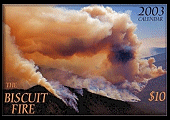






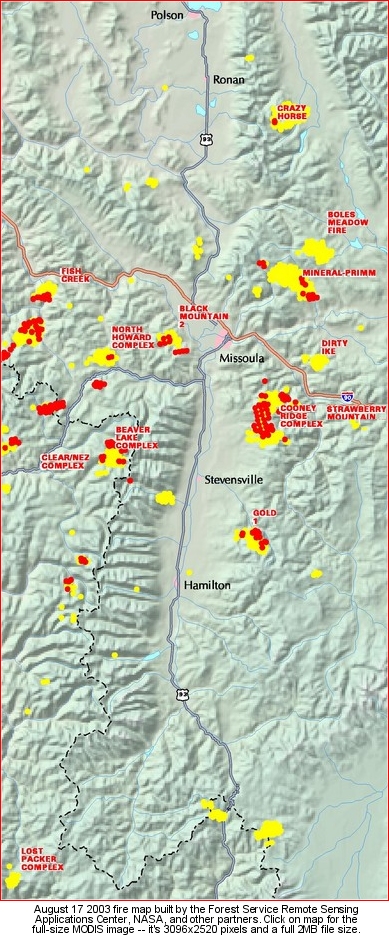

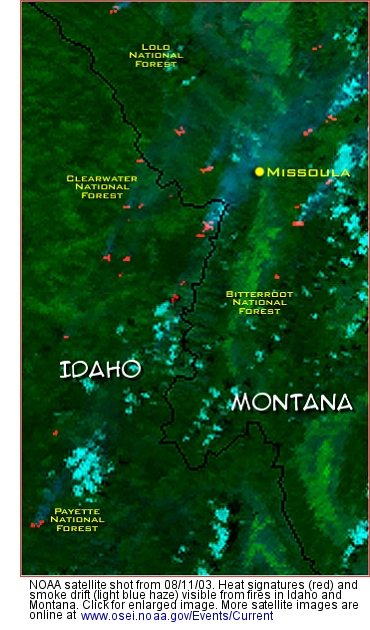
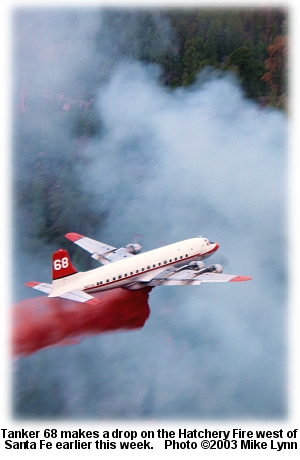 JULY 12 -- SANTA FE, NM: The 5,222-acre Encebado Fire on Taos Pueblo in New Mexico is about 40 percent contained; according to
JULY 12 -- SANTA FE, NM: The 5,222-acre Encebado Fire on Taos Pueblo in New Mexico is about 40 percent contained; according to 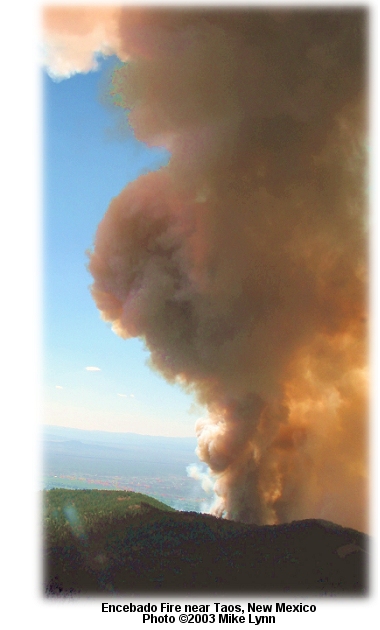 The Southwest region was busy with heavy initial attack yesterday, with 55 fires reported. All but one were caused by lightning.
The Southwest region was busy with heavy initial attack yesterday, with 55 fires reported. All but one were caused by lightning.
 This is by no means the first time that Western forests have been targeted. On September 9, 1942, a small plane piloted by Nobuo Fujita was launched from the deck of a Japanese submarine near Cape Blanco, off the coast of Oregon. Fujita flew inland, dropping incendiary bombs. The plan was to ignite huge wildfires that would be hard to fight because of their size and the lack of manpower. The plan would weaken the Americans' ability to wage war in the Pacific, threaten West Coast communities, and terrorize the Americans.
This is by no means the first time that Western forests have been targeted. On September 9, 1942, a small plane piloted by Nobuo Fujita was launched from the deck of a Japanese submarine near Cape Blanco, off the coast of Oregon. Fujita flew inland, dropping incendiary bombs. The plan was to ignite huge wildfires that would be hard to fight because of their size and the lack of manpower. The plan would weaken the Americans' ability to wage war in the Pacific, threaten West Coast communities, and terrorize the Americans.
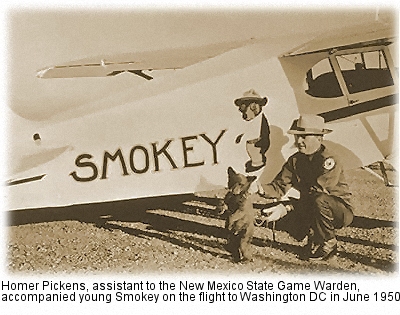 Smith enjoyed telling stories about Smokey, said his wife, Twilla Eddy Smith. "Smokey was his favorite patient, he really was," she said. "Ed loved that little bear. He had no idea, when he took care of him, that Smokey would end up being such a symbol."
Smith enjoyed telling stories about Smokey, said his wife, Twilla Eddy Smith. "Smokey was his favorite patient, he really was," she said. "Ed loved that little bear. He had no idea, when he took care of him, that Smokey would end up being such a symbol."
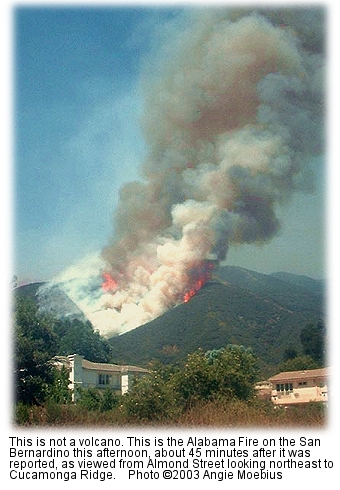 The Summit Fire started about 1:30 p.m. in the Mountain Ranch area; the Dinely Fire, which started about 1 p.m. near Three Rivers, was at over 100 acres by 3 p.m. this afternoon. It had five airtankers, five helicopters, and air attack assigned.
The Summit Fire started about 1:30 p.m. in the Mountain Ranch area; the Dinely Fire, which started about 1 p.m. near Three Rivers, was at over 100 acres by 3 p.m. this afternoon. It had five airtankers, five helicopters, and air attack assigned.
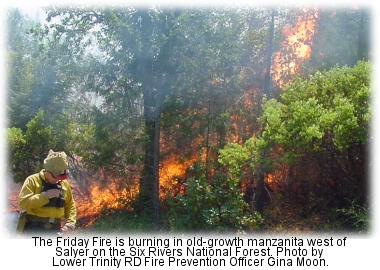 Another fire burned more than 120 acres southeast of Temecula on unincorporated county land. Five airtankers, four helicopters, and two dozers assisted ground crews on the fire. The fire was the fifth in the region in recent days to require air crews.
Another fire burned more than 120 acres southeast of Temecula on unincorporated county land. Five airtankers, four helicopters, and two dozers assisted ground crews on the fire. The fire was the fifth in the region in recent days to require air crews.
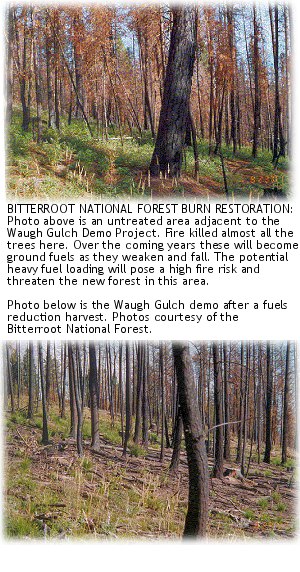 In Oregon, U.S. District Court Judge Michael Hogan recently denied a Forest Service request to cut burned dead trees on two Montana salvage sales -- the Coal Little Blue and Skalkaho on the Bitterroot National Forest.
In Oregon, U.S. District Court Judge Michael Hogan recently denied a Forest Service request to cut burned dead trees on two Montana salvage sales -- the Coal Little Blue and Skalkaho on the Bitterroot National Forest.
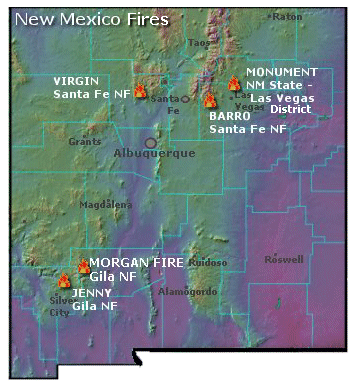 More than 250 firefighters, including seven hotshot crews, are expected to arrive today at the Virgin Fire. Two airtankers are assigned. The
More than 250 firefighters, including seven hotshot crews, are expected to arrive today at the Virgin Fire. Two airtankers are assigned. The 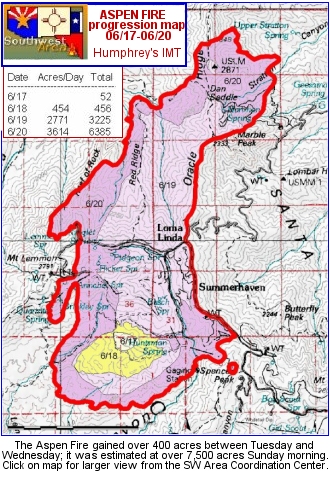
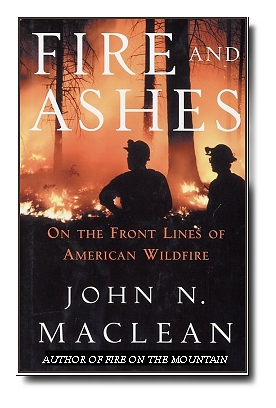 The collection of stories in FIRE AND ASHES proves up both Maclean's dogged pursuit of history and his determined focus on accuracy that comes from 30 years of journalism experience. Covering many thousands of miles, dozens of interviews, and painstaking attention to detail in his writing, Maclean has crafted a book that puts his readers out on the fireline.
The collection of stories in FIRE AND ASHES proves up both Maclean's dogged pursuit of history and his determined focus on accuracy that comes from 30 years of journalism experience. Covering many thousands of miles, dozens of interviews, and painstaking attention to detail in his writing, Maclean has crafted a book that puts his readers out on the fireline.